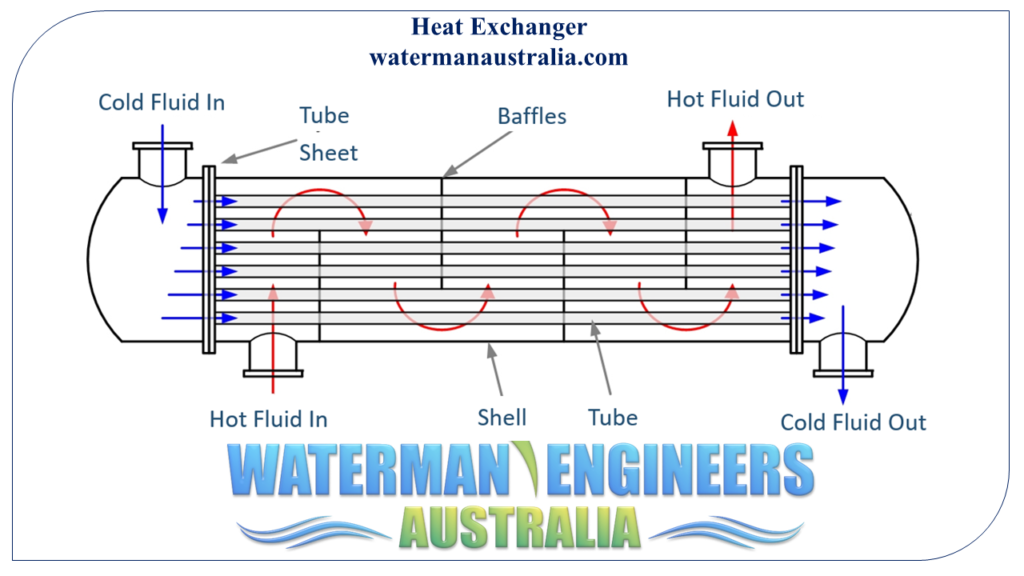
A heat exchanger is a device that allows for the transmission of heat between two different media without any physical contact between them. Heat exchangers work on the idea that thermal energy can be transferred from a hot fluid to a cold fluid. Heat exchangers provide for precise temperature regulation, improving energy efficiency and system functionality by transferring heat between two fluids.
Power plants, chemical plants, HVAC (heating, ventilation, and air conditioning) systems, supermarkets, and many more all employ heat exchangers. They can be found in commonplace home products like air conditioners and water heaters.
In this article, we'll learn about heat exchangers, what they are, how they work, and the different kinds there are. The article also details the common uses and factors to consider when choosing a heat exchanger.
These layers of deposits represent extra resistance to the transfer of heat, so periodic cleansing and routine maintenance is sometimes needed to maintain the heat exchanger Doing work at most efficiency.
The main fluid is water although the secondary fluid is air blown in the fins from the heat exchanger with fans. Normally, there won't be any moving pieces from the heat exchanger only exterior enthusiasts to circulate the air.
A corrosive fluid need to be place around the tube side in order to decrease the quantity of highly-priced corrosion-resistant material employed.
Sketch of outside air (moving into the EAHX) and EAHX exit air temperatures for a standard summertime day. Space upper and reduced setpoint temperatures delimiting Workplace place thermal comfort and ease also represented.
The Contactor: The contactor is essentially a Manage which is made use of to get the voltage switched in your furnace heating element. It really works specifically with all your thermostat, that means In the event the thermostat doesn’t have an exceedingly substantial voltage, the contactor will be energized by it.
Despite the fact that in most of the conditions the thermal structure of S&T heat exchangers is executed from the purchaser, the mechanical style could have an impact on the thermal effectiveness.
The final principles of the mechanical design of the next varieties of exchangers are offered while in the
They heat up the air within the heat exchanger. Gasoline is shipped to those burners, which can be ignited by the new floor igniter or perhaps the pilot light, sending heat on the heat exchanger.
nine. Nozzles. Most nozzles are sized to match the adjacent plan piping. The openings from the barrels have to have reinforcement in accordance Along with the appropriate pressure vessel code which subsequently will limit the most dimensions of nozzle opening.
Destruction that occurs for the heat exchanger allows exhaust fuel to flee and contaminate your property with carbon monoxide.
The weld neck flange style, which has a tapered hub with a clean tension changeover and accessibility for complete nondestructive evaluation, offers the very best integrity of the 3 types. A flange contains three subcomponents: the flange ring, the gasket plus the bolting. The productive Procedure Designing of heat exchanger manufacturer of the flange is dependent upon the proper alternative, design and assembly of those subcomponents. The Heat Exchange Design and style Handbook contains two chapters discussing these things.
The e book is extensively illustrated with figures in help in the textual content and involves calculation illustrations to be sure consumers are fully equipped to choose, design, and run heat exchangers.
Heat exchangers encounter extra force drop because they get fouled due to a reduction in the region from the stream passages. Although fouling resistance is considered by almost all designers to account for that loss in heat transfer, only a few of them look at fouling layer thickness to account for the upper force fall. This is extremely anomalous because the deposit will come very first and after that, like a consequence, the thermal resistance.
An axial stream unit makes use of a considerable wheel. The air warms a single aspect on the wheel, which transfers heat on the cold air stream as it slowly turns. A heat pipe device makes use of refrigerant to transfer the heat. Other models can be found for specialised purposes. Tiny buildings, like homes, frequently use counter-flow or cross-circulation exchangers.